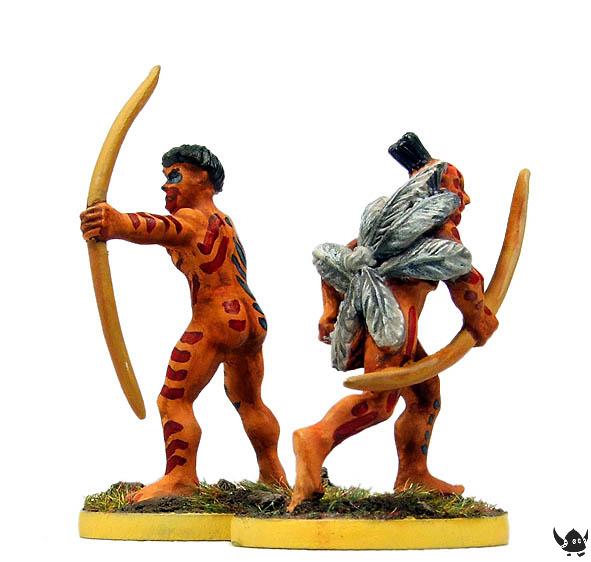South American Tupi
The Europeans used the name Tupi as a convenient term to collectively describe the numerous tribes who occupied the long Brazilian coast, from the mouth of the Amazon to at least as far south as modern day Sao Paulo. Although linked by a broadly common language and cultural similarities the Tupi were comprised of many different tribes, with their own subtle but distinct identities. These included the Tupinambá, Tupinikin, Tupina, Potiguara, Creté, Tobayara and the Temiminó tribes, along with all their various subgroups.

Initial relations between Tupi and Portuguese were cordial, driven by a mutual curiosity on both sides. Many early explorers wrote effusive descriptions of the ‘noble savage’ and their carefree utopian world of shared property and the simple life. However they were less impressed by the Tupi’s propensity for continuous inter tribal warfare and the realisation that one of its primary motives was the desire to collect live prisoners for regular cannibalistic rituals. As the author John Hemming has pointed out, it was perhaps unfortunate for the rest of the indigenous population of Brazil that the Europeans’ first point of contact with them should have been such enthusiastic cannibals as the Tupi. Revulsion and sensationalism at the practice became engrained and extended in the European mind to be associated with all South American ‘savages’, even though beyond the Tupi, and their near neighbours the Aimoré, ritualistic cannibalism was rare amongst the tribes occupying the vast Brazilian interior. Needless to say the practices of the Tupi alone provided the Portuguese and other Europeans with all the self justification they needed to ‘civilise’ and religiously convert all the Indian populations – the reality of which meant a long process of economic exploitation and enslavement. The Tupi, not surprisingly, resisted violently.
European political rivalries also took a hand. The Portuguese found themselves in direct competition with French adventurers trying to set up their own economic ties with the region. Neither side had enough resources to seriously counter the other’s ambitions across Brazil’s broad, forested geography, so both were soon forming alliances with Tupi tribes and manipulating tribal rivalries to fight their battles for them. This set the tone for a century of colonial warfare: European against European; European against Tupi; Tupi against Tupi - in a ceaseless procession of battles, sieges, raids, guerrilla ambushes and native revolts. Despite many victories, one by one the Tupi tribes succumbed to European military technology (and European diseases) with some groups being totally exterminated. The last revolt came in 1601 after which the surviving Tupi were employed by their Portuguese masters against the Aimoré tribes of the interior.

The Tupi resided in defendable palisaded villages, sharing communal long houses in extended family groups. Tupi warfare was not regimented and predominantly of a skirmishing and raiding tradition. However, large forces were sometimes assembled and pitched battles fought with both sides confronting each other in dense lines, a bow shot apart. Living on the coast and along the rivers, the Tupi were also skilled canoeists capable of launching waterborne attacks and even fighting opponent’s canoe forces on the open sea. Their principal weapon was the bow, which witnesses record they could fire very rapidly, at a rate faster than any European bowman. They also carried the tacape, a paddle shaped wooden club with sharpened edges which was long and heavy and usually welded with both hands. Some tribes carried shields, but not apparently for hand to hand combat but more for protection at a distance from arrows. The French attempt to introduce firearms in some quantities but accounts suggest only a few ever seem to make it onto the battlefield. Tupi fought naked, except for the frequent use of red and black body paint and occasional colourful feather adornment. The principal distinction in the appearance of some tribes seems to have been different haircuts, and our range of figures reflects this. In the coming months we will be adding a range of 28mm Colonial Portuguese to compliment these figures.

For those interested to know more about the Tupi, and the fate of Brazil’s other indigenous tribes, we would recommend Red Gold. The Conquest of the Brazilian Indians 1500-1760 by John Hemming. Currently out of print we think, but well worth tracking down a copy. The excellent Foundry Books publication Armies of the 16th Century: volume 2 by Ian Heath which covers all the Americas provides lots of useful detail for the gamer and figure painter. The more intrepid might like to seek out the seminal 1971 Portuguese movie Como Era Gostoso o meu Francês (“How tasty was my little Frenchman”). Although regarded as a satirical film it portrays the period and the Tupi accurately – although a warning – the explicit nudity may offend some viewers. There is also the more recent “Hans Staden” (1999) another Portuguese film and in part a remake of the earlier movie, but more based on the true story of the 16th Century German adventurer of the title who was captured by the Tupi and only narrowly avoided being eaten by them. He later escaped and wrote a 16th Century best seller about his experiences living with the tribe. But once again though, there’s not a lot of clothing being worn!
28mm South American Tupi (16th Century – and later)
Sculpted by Alan Marsh
Figures are sold individually and in any quantity. The number in parentheses at the end of each line indicates the number of different figure variants available for that code. Variants are supplied randomly, but Eureka Miniatures will always endeavour to ensure customers receive a representative sample of all the variants.





























